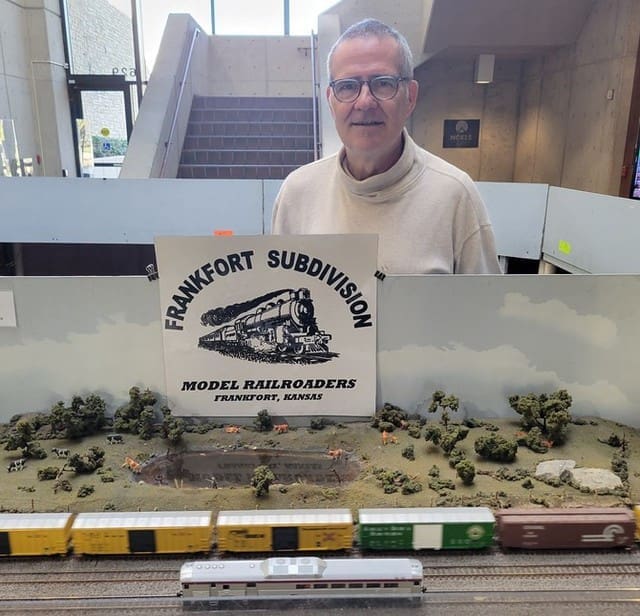By Ron Wilson, director of the Huck Boyd National Institute for Rural Development at Kansas State University
“It’s a train set!”
That sounds like an excited child when a model railroad set is delivered as a Christmas gift or birthday present. I remember that excitement as a boy.
Assembling and operating a model train set can offer hours of fun entertainment. Model trains can provide entertainment and even education for adults as well. Today we’ll meet a group of model railroaders who are sharing this enjoyment with others in rural Kansas.
Les Kuehne is a volunteer with the Frankfort Subdivision Model Train Club. Kuehne worked in Manhattan and retired from the Farrar Corporation, but always enjoyed model trains.
“My uncle gave me a train set as a kid,” Kuehne said.
Model trains are tiny replicas of the real thing. They have long held a fascination among groups of train enthusiasts. The Manhattan Area Rail Joiners group was one such group. Manhattan doctor Roger Reitz was an active member of this group, for example.
When that group ended, some members wanted to continue. At the time, they had model railroad supplies stashed in trailers.
“One of our members worked for Wanklyn Oil and they had an empty storage building in Frankfort,” Kuehne said. “We got permission to use that and it became our clubhouse.” Kuehne said.
Using the term “subdivision,” which described a segment of railway from the old steam engine days, the group reformed itself as the Frankfort Subdivision Model Train Club. Jim Turner of Olsburg and others are active in the group along with Kuehne.
The Frankfort Subdivision researches and educates people about the rail history of Kansas. The group is also committed to the enjoyment of model railroading and helps individuals model their own railroads.
At the clubhouse in Frankfort, the club has a permanent layout of its HO model trains. Sections of the small track, as displayed in six-foot models of a particular landscape, are called modules. Those modules are then assembled, connected into a complete track, and displayed at various events and locations around the region. These include the train show in Lincoln, Nebraska, the Wamego Tulip Festival, Herington Railroad Days, Olsburg Fall Festival, Topeka Train Show, Manhattan Public Library and more.
The modules are built to conform with the standards of the National Model Railroads Association. They are placed on platforms for easy viewing and connected together, with electrical connections beneath them to operate the trains. When kids see the displays, many are fascinated by the moving trains and the tiny landscapes in which they operate.
The Frankfort Subdivision has approximately 30 modules. Volunteers have learned how to set up and operate a display in a mere two hours.
A typical display would have three lanes of track with trains moving in different directions. The trains might go through tunnels, over rivers, and around buildings. It’s especially fun to see the tiny model landscapes in which they are displayed.
Each module may depict a particular landscape, such as a farm scene, train yard, industrial area, or downtown. These include tiny buildings with tiny people. Some are whimsical, such as the Addams Family module, or the one with little dinosaurs among the trees.
“The detail work on these modules is an art form,” Kuehne said.
“We get to share our hobby with people and also provide education,” he said. “Sometimes engineering students have to build displays like this so we can help them.”
“I’m involved with Operation Lifesaver, which is a railroad crossing safety initiative,” he said. “There’s also a Boy Scout merit badge in model railroading. We’re glad to have fun with trains while providing a public service.”
It’s good to find this group sharing their interest while based in the rural community of Frankfort, population 717 people. Now, that’s rural.
For more information, find Frankfort Subdivision Model Train Club on Facebook.
We commend Les Kuehne, Jim Turner, and all those involved with the Frankfort Subdivision for making a difference with their enthusiasm for model trains.
So what is it that can provide excitement and education about railroads for both young and old alike? The answer is: it’s a train set.
Audio and text files of Kansas Profiles are available at https://www.huckboydinstitute.org/kansas-profiles/. For more information about the Huck Boyd Institute, interested persons can visit http://www.huckboydinstitute.org.













